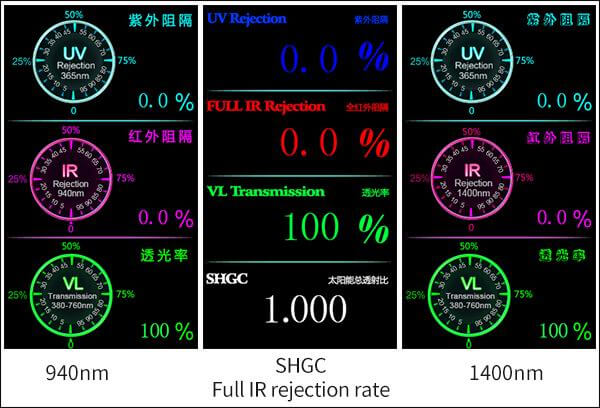SHGC,TSER,SC and G-value
1.SHGC: Solar Heat Gain Coefficient
SHGC is the successor to the shading coefficient used in the United States and it is the ratio of transmitted solar radiation to incident solar radiation of an entire window assembly. It ranges from 0 to 1 and refers to the solar energy transmittance of a window or door as a whole, factoring in the glass, frame material, sash (if present), divided lite bars (if present) and screens (if present). Many people who want to purchase window films are very concerned about the SHGC value of the window film. But how do you know the SHGC value of the window films?

We need to use a professional window tint meter. Linshang LS182 solar film transmission meter, also named window tint meter, can test the UV rejection rate at 365nm, IR rejection rate at 940nm and 1400nm, visible light transmittance at 550nm and SHGC value of the window films.
2.TSER: Total Solar Energy Rejection
This is calculated across all the sun’s wavelengths and even includes the portion of heat that is absorbed by the glass and reradiated inwards. Linshang Technology also provides customized services for TSER data (for LS182 window tint meter), the minimum order quantity is 50 units, please contact sales21@linshangtech.com for details
3. SC: Shading Coefficient
The shading coefficient (SC) is a measure of the radiative thermal performance of a glass unit (panel or window) in a building. It is defined as the ratio of solar radiation at a given wavelength and angle of incidence passing through a glass unit to the radiation that would pass through a reference window of frameless 3 millimeters (0.12 in) clear Float Glass.
The SC shading coefficient can be converted by the SHGC value, SC = SHGC ÷ 0.87 (or 0.889)
4.G-Value: Solar Factor or Total Solar Energy Transmittance
G-value (sometimes also called a Solar Factor or Total Solar Energy Transmittance) is the coefficient commonly used in Europe to measure the solar energy transmittance of windows. Despite having minor differences in modeling standards compared to the SHGC, the two values are effectively the same. A g-value of 1.0 represents full transmittance of all solar radiation while 0.0 represents a window with no solar energy transmittance. In practice though, most g-values will range between 0.2 and 0.7, with solar control glazing having a g-value of less than 0.5.
As a manufacturer of professional glass thickness measuring tools, Linshang Technology can not only help you measure the shading coefficient and SHGC of glass, but also measure the visible light transmittance, infrared transmittance /rejection rate, ultraviolet transmittance / rejection of glass. For more product information, please refer to the following two articles:
(1) Glass Thickness Gauge Selection and FAQ
(2) Window Tint Transmission Meter Selection and FAQ
- Factors Affecting UV Ink Curing and Selection of UV Energy Meter
- What is SHGC? Can We Use LS182 Window Tint Meter to Measure TSER and SC?
- Principle and Function of Ceramic Portable Gloss Meter
- Light Transmittance Meter LS117 for Smart Glass
- What is the Solar Heat Gain Coefficient Ratings (SHGC)
- Some Advantages of Insulating Glass

